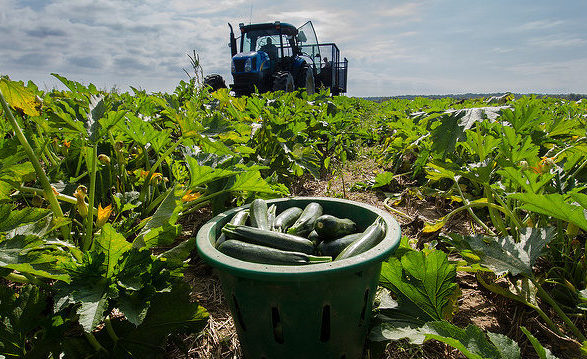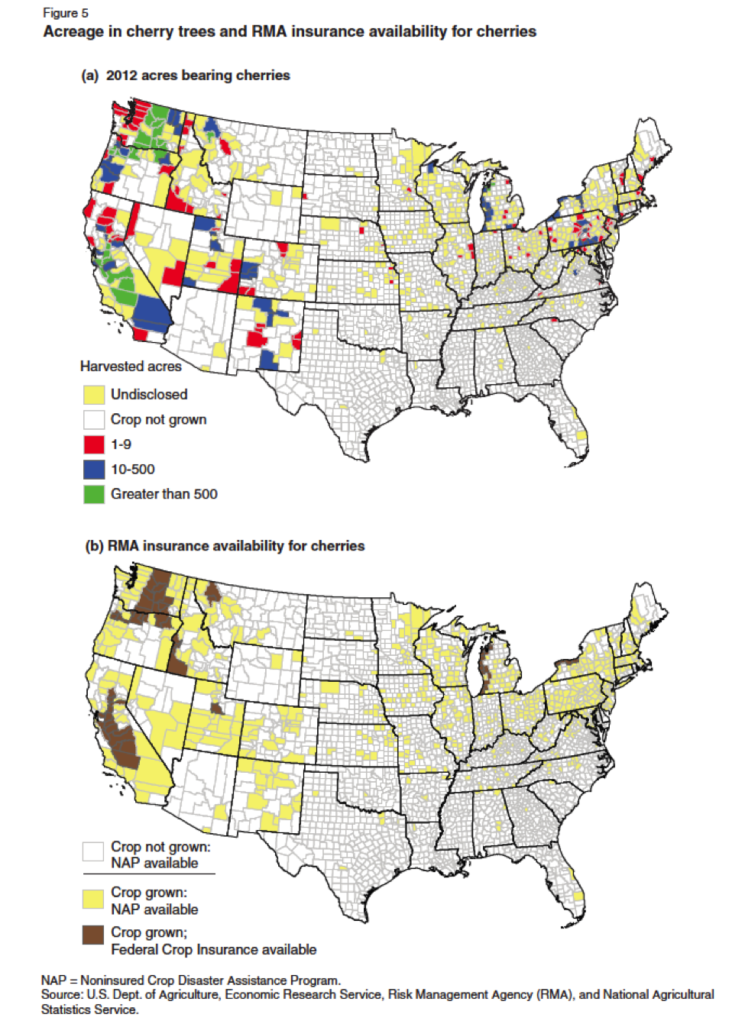
Last week, the US Department of Agriculture’s (USDA) Economic Research Service (ERS) released a new report indicating that changes to the Noninsured Crop Disaster Assistance Program (NAP) made in the 2014 Farm Bill have been well-received by farmers and have led to a doubling of NAP applications – from 66,000 in 2014 to 138,000 in 2015. While this is great news for farmers and for NAP, there are still thousands of farmers that don’t have access to federal risk management support.
The upcoming 2018 Farm Bill provides an opportunity for Congress to continue to improve NAP so that the program is more effective, efficient, and better serves historically underserved farmer groups (e.g., beginning, specialty crop, highly diversified, and organic farmers). As part of our farm bill work, the National Sustainable Agriculture Coalition (NSAC) has developed several proposals to continue improving NAP by expanding access and addressing some of the growing pains the program has experienced following its increased popularity.
Because the federal crop insurance program does not adequately address the needs of all farmers, it is important that NAP be able to fill the coverage gap; by expanding farmers’ risk management options we can protect family farm livelihoods, as well as create a more secure and stable food supply.
NAP Improvements from the 2014 Farm Bill
NAP was first introduced in the 1994 Farm Bill as a way to move away from ad hoc disaster assistance programs and establish a better safety net for farmers with crops not covered by the U.S. Department of Agriculture’s (USDA) federal crop insurance program. Under the original version of NAP, producers could only purchase catastrophic coverage that covered yield losses greater than 50 percent of the expected yield, at 55 percent of the average market price (NAP Basic); a rate so low that it earned the program the moniker, the “Not a Penny” program.
Chief among the improvements made to NAP via the 2014 Farm Bill was the inclusion of a provision that makes it possible for producers to pay a premium for coverage up to 65 percent of the approved yield at 100 percent of average market price (NAP Buy-Up). The bill also introduced discounts for beginning farmers, and minority and socially disadvantaged farmers, which also contributed to the increase in applications.
The expansion of NAP is an important part of strengthening the farm safety net, particularly for historically underserved producers. NAP provides an option for farmers in areas where crop insurance is not available for the crops they grow; it can even provide important data on price and quantity, which could help to expand the availability of traditional crop insurance to areas where it is not currently available.
The changes in the 2014 Farm Bill have been an encouraging step in the right direction, but additional changes are needed in the upcoming 2018 Farm Bill in order to ensure more equitable access to crop insurance and risk management tools for producers nationwide.
Find out more about current NAP rules in NSAC’s Grassroots Guide.
Continuing to Improve: Recommendations for the 2018 Farm Bill
While the 2014 Farm Bill’s improvements to NAP were largely positive, increased enrollment in the program has also come with increased reports of problems and challenges from producers. Chief among these challenges has been reported delays in NAP’s identification of approved yield and approved price; producers need to have a complete understanding of approved yield and price in order to know what level and type of coverage will best meet their needs. Producers have also reported challenges in applying NAP to small acreages (operations on which a farmer has only a partial acre up to a few acres of a particular crop). This is especially problematic for specialty crop or diversified producers, for which a small acreage of specialty crops may represent a large portion of the farmer’s income.
Federally subsidized crop insurance, overseen by USDA’s Risk Management Agency (RMA), is currently available for over 100 crops, but most of those policies are only available in a limited number of states and counties. Additionally, coverage availability has been historically tilted toward commodity crops, resulting in limited coverage for fruit, nut, and vegetable crops – aka “specialty crops.” For example, less than 10 percent of the 2.2 million federal crop insurance polices sold in 2015 were for specialty crops.
As part of our 2018 Farm Bill platform, the National Sustainable Agriculture Coalition (NSAC) will propose the creation of a revenue option (either on a crop or whole farm basis) in NAP for small acreages, expanded provisions supporting beginning farmers, and a more streamlined process for determining an approved price.
When NAP was first developed, it was used mostly for grass and a select number of other crops for which no crop insurance policy was available; still today 41 percent of NAP applications are for grass. As specialty crop producers have increasingly looked to NAP for their risk management coverage, a host of problems associated with administering NAP for small acreages have also been brought to light. Even a single acre of certain high-value specialty crops can generate tens of thousands of dollars of revenue for farmers, making efficient management of NAP’s small acreage programs critical.
NSAC recommends that Congress give USDA’s Farm Service Agency (FSA) limited authority to develop a revenue policy for small acreages that could be used in lieu of the yield-based policy used for most crops today. FSA already has limited authority to offer revenue policies for certain crops, such as Christmas trees and other ornamental plants, which do not lend themselves to a yield calculation.
NAP can also be an important tool, alongside Whole-Farm Revenue Protection (WFRP), for providing risk management tools to diversified farms, beginning farmers, and those operating in local and regional food systems. NSAC supports the creation special provisions within the NAP program that will allow beginning farmers to build the revenue history they need in order to qualify for WFRP. Currently, a farmer needs four years of revenue history in order to participate in WFRP, which seriously disadvantages beginning farmers. NSAC proposes a special provision be created within NAP for qualifying beginning farmers. The provision would use the existing NAP fee structure (including all discounts) but would provide expanded coverage for any crop covered by WFRP, coverage levels equal to those available in crop insurance. Such a provision would also be subject to all the limitations on payments included in NAP; and in order to ensure the provision is targeted to beginning farmers, qualification would be limited to the number of years needed to develop the revenue history for WFRP (currently four).
Lastly, the procedures for developing approved prices for NAP need to be streamlined. Currently, developing an approved price can take months, seriously delaying the availability of coverage. Changes since 2014 have improved the process, but there are still too many layers of bureaucracy. In this vein, NSAC also recommends that FSA be allowed to maintain cooperative agreements with state governments and the NGO community to collect price information. This kind of data is critical to NAP and can help improve program performance.
Reducing the Risk of Low Revenue
In addition to highlighting the increased interest in NAP, ERS’ report also reveals that NAP has a significant impact on limiting the risk of extremely low realized revenue for farmers, while only slightly increasing expected total revenue. This is to say that NAP, especially buy-up NAP, can help reduce the risk of a loss that would put a farmer out of business without being so generous as to provide a large impact on upside revenue potential. In this way, NAP represents what risk management coverage is intended to be for – protection during times of loss or from unforeseen disasters, not a revenue guarantee tool. The federal crop insurance program’s generous benefits have been criticized on that point, and the early experience with NAP buy-up coverage, as detailed in the ERS report, suggests that it may help inform a more fiscally responsible approach to risk management.
Three Case Studies: Cherries, Pecans, and Squash
Three case studies (cherries, pecans, and squash) are used in the report to show producers’ use of NAP as a risk management tool. In the case of cherries, Michigan accounted for a large percentage of the increase in total NAP applications with 259 policies, 59 percent of which were for buy up. Oregon and New York were not far behind with 180 and 62 policies respectively. Overall, NAP policies for cherries increased from 169 to 631 from 2014 to 2015.
Most counties with reported commercial cherry production don’t have a federal crop insurance policy available, and so in these areas NAP is the only risk management option. Crop insurance cherry policies are available in only a few counties in eight states, although reported commercial cherry production takes place at varying levels in over 48 states. The maps below, taken from the ERS report, illustrate the disparity between the availability of crop insurance for cherries compared to the areas where they are grown.

Pecans are another interesting case when looking at NAP because they are widely grown but can only be covered by federal crop insurance in a limited number of counties in eight states. According to the ERS report: “[More] U.S. farmers produce pecans than all other tree nuts combined, and while pecans have the second-highest of bearing acres for any nut in the United States, the average bearing acres per pecan operation are less than those of almonds, pistachios, walnuts, and hazelnuts.”
The report focuses on pecans grown in Oklahoma and Texas because they have a large number of counties with over 500 bearing acres of pecans, but few counties where crop insurance is available. In fact, most pecan operations in those states do not have access to the federal crop insurance program. As a result of the improvements made to NAP, from 2014 to 2015 there was an increase from 26 to 167 applications from pecan growers in Oklahoma, and an increase from 56 to 84 in Texas. This occurred while crop insurance enrollment for pecans remained steady at 1,500.
The final crop analyzed by the report, squash, is one of the most widely grown crops in the U.S. since it is so well adapted to a variety of climates. Squash production is widely disbursed across the country; with the exceptions of NY, CA, FL, MI, no other state accounts for more than 5 percent of total volume of production. It is also important to know when looking at NAP for squash that there is currently no crop insurance policy available for this crop, making NAP the only available risk management tool for these producers.
Squash was among the crops with the top four highest NAP applications in both 2014 and 2015 (applications rose from 1,940 in 2014 to 5,421 in 2015). In 2015, four states had 500 or more applications and 12 other states had 100 or more applications.
The case studies of cherries, pecans, and squash clearly demonstrate the changes made to NAP as part of the 2014 were effective and well received by farmers. As mentioned above, however, serious challenges and obstacles still remain – particularly for historically underserved farmer groups. NSAC looks forward to working with our partners in Congress to ensure that risk management options are expanded and customized so that they can adequately meet the needs of our nation’s diverse farmers, ranchers, and food producers.

